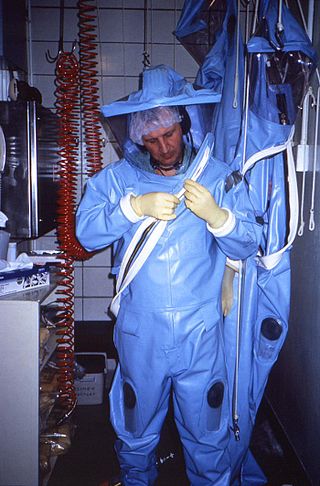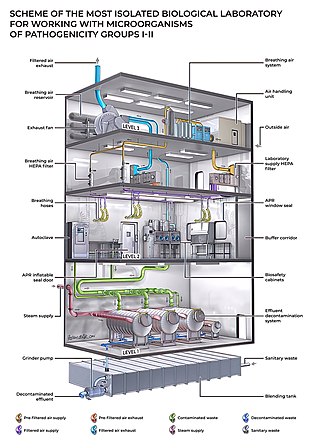Related Research Articles

Saskatchewan is a province in Western Canada, bordered on the west by Alberta, on the north by the Northwest Territories, on the east by Manitoba, to the northeast by Nunavut, and on the south by the United States. Saskatchewan and Alberta are the only landlocked provinces of Canada. In 2023, Saskatchewan's population was estimated at 1,221,439. Nearly 10% of Saskatchewan's total area of 651,900 km2 (251,700 sq mi) is fresh water, mostly rivers, reservoirs, and lakes.

Biosafety is the prevention of large-scale loss of biological integrity, focusing both on ecology and human health. These prevention mechanisms include the conduction of regular reviews of biosafety in laboratory settings, as well as strict guidelines to follow. Biosafety is used to protect from harmful incidents. Many laboratories handling biohazards employ an ongoing risk management assessment and enforcement process for biosafety. Failures to follow such protocols can lead to increased risk of exposure to biohazards or pathogens. Human error and poor technique contribute to unnecessary exposure and compromise the best safeguards set into place for protection.

A biosafety level (BSL), or pathogen/protection level, is a set of biocontainment precautions required to isolate dangerous biological agents in an enclosed laboratory facility. The levels of containment range from the lowest biosafety level 1 (BSL-1) to the highest at level 4 (BSL-4). In the United States, the Centers for Disease Control and Prevention (CDC) have specified these levels in a publication referred to as BMBL. In the European Union, the same biosafety levels are defined in a directive. In Canada the four levels are known as Containment Levels. Facilities with these designations are also sometimes given as P1 through P4, as in the term P3 laboratory.

Regina is the capital city of the Canadian province of Saskatchewan. The city is the second-largest in the province, after Saskatoon, and is a commercial centre for southern Saskatchewan. As of the 2021 census, Regina had a city population of 226,404, and a Metropolitan Area population of 249,217. It is governed by Regina City Council. The city is surrounded by the Rural Municipality of Sherwood No. 159.

The University of Saskatchewan is a Canadian public research university, founded on March 19, 1907, and located on the east side of the South Saskatchewan River in Saskatoon, Saskatchewan, Canada. An "Act to establish and incorporate a University for the Province of Saskatchewan" was passed by the provincial legislature in 1907. It established the provincial university on March 19, 1907 "for the purpose of providing facilities for higher education in all its branches and enabling all persons without regard to race, creed or religion to take the fullest advantage". The University of Saskatchewan is the largest education institution in the Canadian province of Saskatchewan. The University of Saskatchewan is one of Canada's top research universities and is a member of the U15 Group of Canadian Research Universities.

Thomas Walter Scott was the first premier of Saskatchewan from 1905 to 1916. Scott was Saskatchewan's second longest-serving Premier, serving one continuous term from 1905 to 1916). He led the Saskatchewan Liberal Party in three general elections, winning all three with majority governments before retiring. He was the first of six Liberal Premiers to date. He was succeeded by William Melville Martin. Scott was also the minister of various departments during his tenure as premier. Prior to the creation of Saskatchewan in 1905, Scott was a Member of Parliament in the federal House of Commons of Canada, elected in the general elections of 1900 and 1904.

The University of Regina is a public research university located in Regina, Saskatchewan, Canada. Founded in 1911 as a private denominational high school of the Methodist Church of Canada, it began an association with the University of Saskatchewan as a junior college in 1925, and was disaffiliated by the Church and fully ceded to the university in 1934; in 1961 it attained degree-granting status as the Regina Campus of the University of Saskatchewan. It became an autonomous university in 1974. The University of Regina has an enrolment of over 15,000 full and part-time students. The university's student newspaper, The Carillon, is a member of CUP.

Plum Island Animal Disease Center (PIADC) is a United States federal research facility dedicated to the study of foreign animal diseases of livestock. It is a national laboratory of the Department of Homeland Security (DHS) Directorate for Science and Technology (S&T), and operates as a partnership with the U.S. Department of Agriculture (USDA). The facility's director is Dr. Larry Barrett.

The First Nations University of Canada is a post-secondary institution and federated college of the University of Regina, based in the Canadian province of Saskatchewan. FNUniv operates three campuses within the province, in Prince Albert, Regina, and Saskatoon. The university offers academic programs in business, the humanities, social sciences, and sciences; including a number of programs focused around aboriginal practices.
The National Microbiology Laboratory (NML) is part of the Public Health Agency of Canada (PHAC), the agency of the Government of Canada that is responsible for public health, health emergency preparedness and response, and infectious and chronic disease control and prevention.

Grenfell is a town in Southern Saskatchewan, Canada. It is situated at the junction of Highway 47 and the Trans-Canada Highway 1 80 miles (130 km) east of Regina, the provincial capital. It is 15 miles (24 km) south of the Qu'Appelle Valley where Crooked Lake Provincial Park and Bird's Point Resort are popular beach destinations in summer and are accessed by Highway 47.
The Saskatchewan Research Council (SRC) is a provincial treasury board crown corporation engaged in research and technology development on behalf of the provincial government and private industry. It focuses on applied research and development projects that generate profit. Some of its funding comes from government grants, but it generates the balance from selling products and services. With nearly 300 employees and $137 million in annual revenues, SRC is the second largest research and technology organization in Canada.
Innovation Place is the registered business name of the Saskatchewan Opportunities Corporation (SOCO), a crown corporation in Saskatchewan. SOCO operates two research parks: one located near the University of Saskatchewan in Saskatoon, Saskatchewan, and the second near the University of Regina in Regina, Saskatchewan. In 2018, approximately 140 companies were based at Innovation Place. Research parks such as Innovation Place are sometimes referred to as science parks or technology parks.

The Vaccine and Infectious Disease Organization – International Vaccine Centre (VIDO-InterVac) is a research organization of the University of Saskatchewan that operates with financial support from the Government of Canada, the government of Saskatchewan, livestock industry councils and agencies, foundations and human and animal health companies. In addition to the 2,500,000 sq ft (230,000 m2) facility on campus, VIDO-InterVac also operates a 160-acre (0.6 km2) research station.
MaRS Discovery District is a not-for-profit corporation founded in Toronto, Ontario, Canada in 2000. Its stated goal is to commercialize publicly funded medical research and other technologies with the help of local private enterprises and as such is a public-private partnership. As part of its mission MaRS says, "MaRS helps create successful global businesses from Canada's science, technology and social innovation." As of 2014, startup companies emerging from MaRS had created more than 4,000 jobs, and in the period of 2011 to 2014 had raised over $750 million in capital investments.

The Saskatchewan Arts Board is an arms-length funding agency that provides support to artists, arts organizations and communities. Established in 1948, it was the first agency of its kind in Canada, predating the Canada Council for the Arts by nine years. The Arts Board has offices in Regina and Saskatoon. In May 2020, the agency changed its name to SK Arts.
Expenditures by federal and provincial organizations on scientific research and development accounted for about 10% of all such spending in Canada in 2006. These organizations are active in natural and social science research, engineering research, industrial research and medical research.

The Ministry of Highways is divided into the Operations, Policy and Programs, and Corporate Services Divisions and the Communications Branch. The ministry is the employer of over 1,476 employees diversified amongst 105 communities in Saskatchewan. The current Minister of Highways and Infrastructure is Jeremy Cockrill.
The Regina Qu'Appelle Health Region was a health region in Saskatchewan, Canada. Primarily based in the city of Regina, the health region operated out of 8 hospitals, 10 community health centres, and numerous long-term care facilities and clinics.
Saskatchewan Research Network Incorporated (SRNET) is a research and education network providing networking service support education, research and innovation in the province of Saskatchewan, Canada. SRNET is member-driven and is a not-for-profit member of Canada's National Research and Education Network, which provides dedicated high speed network access to institutions and companies across Canada. SRNet also provides members access to CANARIE, a dedicated network that links similar research networks. The network also interconnects high performance computing resources within the province. SRNET's members link in to 112 international advanced networks in over 80 countries. Membership is open to all research, education and innovation organizations and institutions in Saskatchewan.
References
- ↑ NEW NAME FOR PROVINCIAL LABORATORY
- ↑ Press Release – NEW SASKATCHEWAN DISEASE CONTROL LABORATORY OPENS
- ↑ "New BSL 3 Lab Improves Canadian Biodefense Capabilities". Sternar Media Group LLC. globalbiodefense.com. September 24, 2012.
- ↑ History of the Saskatchewan Disease Control Laboratory
- ↑ "Former Regina laboratory to be taken down". Leader-Post Post Media. January 27, 2012. Retrieved January 27, 2012.